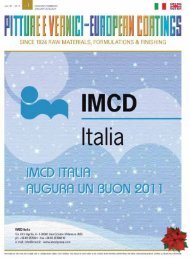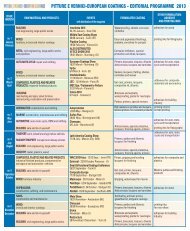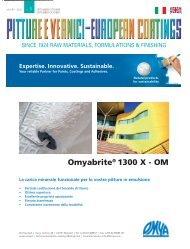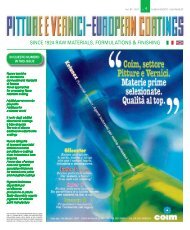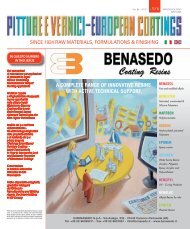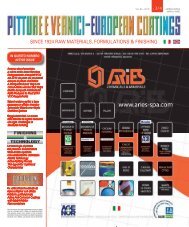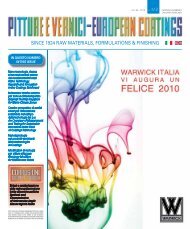since 1924 raw materials, formulations & finishing - PITTURE E ...
since 1924 raw materials, formulations & finishing - PITTURE E ...
since 1924 raw materials, formulations & finishing - PITTURE E ...
You also want an ePaper? Increase the reach of your titles
YUMPU automatically turns print PDFs into web optimized ePapers that Google loves.
luzione NaCl per 24 ore presentano tutte<br />
le bande caratteristiche dei polimeri<br />
e dell’inibitore. Di conseguenza,<br />
l’adesione del complesso è sufficiente<br />
e tale da resistere alla rimozione spontanea<br />
del complesso protettivo dalla<br />
superficie dell’alluminio.<br />
Fig. 7 Test della corrosione a lungo<br />
termine: lega di alluminio<br />
rivestita con coating<br />
polielettrolitico/inibitore<br />
(a sinistra) e lastra di<br />
alluminio non modificata<br />
(a destra)<br />
Long term corrosion test:<br />
aluminium alloy covered by<br />
the polyelectrolyte / inhibitor<br />
coating (left) and unmodified<br />
aluminium plate (right)<br />
its polarity and, consequently, an increase<br />
in the acid properties of the proton. The<br />
characteristic bands from both PSS and HQ<br />
could be also distinguished in the spectrum.<br />
Hence, all components of the coating were<br />
successfully deposited on the metal substrate.<br />
The samples with polyelectrolyte /<br />
inhibitor coating (Figure 6) exhibit dramatically<br />
different behavior. Fig. 6 also depicts<br />
the local current maps over the surface of<br />
the aluminum alloy coated by polymer / inhibitor<br />
film after immersion in 0.1 M NaCl<br />
solution. In this case, the coating was also<br />
mechanically damaged. The scratch is highlighted<br />
by the arrows on the optical photographs<br />
(Fig. 6b). Neither anodic activity nor<br />
corrosion products were observed for the<br />
experiment time of 16 hr (Fig. 6a). The corrosion<br />
suppression is also proved by SEM.<br />
It is amazing that even the nanometer-thick<br />
polyelectrolyte / inhibitor coating provides<br />
effective corrosion protection for the aluminum<br />
alloy. LBL films consisting of polyelectrolytes<br />
and inhibitor can provide three<br />
mechanisms of corrosion protection. The<br />
corrosion inhibitor incorporated as a component<br />
of the LBL film into the protective<br />
coating is responsible for the most effective<br />
mechanism of corrosion suppression.<br />
Quinolines are environmentally friendly corrosion<br />
inhibitors attracting more and more<br />
attention as an alternative to the harmful<br />
chromates. 8-HQ was found to prevent the<br />
adsorption of chloride ions and thus improves<br />
the corrosion resistance due to the<br />
SMART COATINGS - NANOSTRUTTURATI<br />
Per concludere, è stata messa a punto<br />
una nuova tecnica di protezione dalla<br />
corrosione che include il pretrattamento<br />
superficiale mediante trattamento agli<br />
ultrasuoni e deposizione dei polielettroliti<br />
e degli inibitori oppure per incorporazione<br />
dei nanocontainer carichi<br />
di inibitore. Questo metodo ha dato luogo<br />
alla formazione di un veicolo polimerico<br />
intelligente per inibitori organici<br />
ecocompatibili. Il rilascio dell’inibitore<br />
è stimolato dalle specie corrosive e dai<br />
prodotti di corrosione. Quindi, il coating<br />
“intelligente” permette un’azione autorigenerante<br />
prolungata. La natura e<br />
le proprietà del nuovo coating anticorrosione<br />
fornisce simultaneamente tre<br />
meccanismi di protezione dalla corrosione:<br />
passivazione della degradazione<br />
del metallo mediante rilascio<br />
SMART COATINGS<br />
formation of an insoluble chelate of aluminum<br />
which protects the oxide film. Either<br />
mechanical (mechanical scratch) or chemical<br />
(polymer swelling due to changes of<br />
local pH) rupture of the polymer film causes<br />
release of the encapsulated inhibitor,<br />
which occurs in the damaged part of the<br />
metal surface. Therefore, the inhibitor release<br />
occurs in response to corrosion attack.<br />
This results in termination of the<br />
corrosion process and prolongation of corrosion<br />
protection. Finally, defects formed<br />
in the coating by corrosive agents could be<br />
covered due to some mobility of the swollen<br />
polyelectrolyte complex. One possible explanation<br />
is that changing the film environment<br />
from strong corrosive media<br />
(different concentration of salt solutions)<br />
to mild conditions can have an effect similar<br />
to annealing. The salt breaks some of<br />
the anion-cation bonds during the corrosion<br />
attack. The salt removal during the<br />
“rest-time” period (pure water, for example)<br />
leads to bond reformation in a more equilibrated<br />
conformation of the polymer<br />
chains. The role of longrange ionic interactions<br />
in “autorecovery” of polyelectrolyte<br />
multilayers was profoundly studied. Due to<br />
the lower activation energy needed to break<br />
an ionic bond (in comparison with a covalent<br />
bond), partial bond breakage provides<br />
some mobility for the polymer chains. Thus,<br />
gradual evolution of one set of ionic bonds<br />
into the other permits the polymers to relax<br />
in a thermodynamically favorable conformation.<br />
The long-term coating stability in corrosive<br />
environment was studied by dipping the<br />
samples in aqueous NaCl solution at 20°C.<br />
The introduced coatings possess active and<br />
passive corrosion protection combining effective<br />
barrier properties with the possibility<br />
of self-healing of defects in the coating.<br />
Fig. 7 shows pictures of samples coated by<br />
the polymer / inhibitor complex (left) and<br />
without coating (right). Corrosion defects<br />
controllato dell’inibitore, effetto tampone<br />
delle variazioni del pH nell’area<br />
corrosiva grazie agli strati polielettrolitici<br />
e autoriparazione dei difetti del<br />
film dovuta alla mobilità degli elementi<br />
costituitivi polielettrolitici nell’as -<br />
semblaggio strato su strato. Il nuovo<br />
rivestimento presenta una resistenza<br />
molto elevata all’attacco corrosivo, una<br />
stabilità a lungo termine nel veicolo aggressivo<br />
e una procedura di lavorazione<br />
ecocompatibile.<br />
can be observed after 12 hours of immersion<br />
in 0.1 M NaCl on the unmodified aluminum<br />
whereas the sample with the polymer / inhibitor<br />
complex does not exhibit any visible<br />
signs of corrosion attack even after 21 days<br />
of immersion. Furthermore, IRRA spectra of<br />
the covered samples immersed into NaCl solution<br />
for 24 hr exhibit all characteristic bands<br />
of the polymers and the inhibitor. Therefore,<br />
the complex adhesion is sufficient to resist<br />
spontaneous removal of the protective complex<br />
from the aluminum surface.<br />
In conclusions, we have developed a novel<br />
method of anticorrosion protection including<br />
the surface pre-treatment by sonication and<br />
deposition of polyelectrolytes and inhibitors<br />
or incorporation of inhibitor-loaded nanocontainers.<br />
This method results in formation a smart<br />
polymer carrier for environmentally<br />
friendly organic inhibitors. Release of the inhibitor<br />
is stimulated by corrosive species and<br />
corrosion products. Therefore, the smart coating<br />
enables prolongated self-healing activity.<br />
The nature and properties of the novel<br />
anticorrosion coating provide simultaneously<br />
three mechanisms of corrosion protection:<br />
passivation of the metal degradation by controlled<br />
release of inhibitor, buffering of pH<br />
changes at the corrosive area by polyelectrolyte<br />
layers, self-curing of the film defects<br />
due to the mobility of the polyelectrolyte constituents<br />
in the layer-by-layer assembly. The<br />
novel coating exhibits very high resistance to<br />
corrosion attack, long term stability in aggressive<br />
media and environmentally friendly<br />
preparation procedure. The general procedure<br />
has been demonstrated for aluminum<br />
surface important for aircraft industry but is<br />
similarly applicable for many types of surfaces<br />
thus enabling many applications in advanced<br />
technologies. Also here we concentrated<br />
on corrosion, the method could also be<br />
more generally applicable for self-repairing<br />
coating like antifungal or antifriction.<br />
CURRICULUM VITAE<br />
La procedura generale è stata dimostrata<br />
in relazione alla superficie dell’alluminio,<br />
importante per l’industria<br />
aeronautica, ma può essere applicata<br />
altresì a molte tipologie di superfici, così<br />
da permettere molte applicazioni nell’area<br />
di tecnologie avanzate. Anche in<br />
questo caso, ci si è concentrati sulla<br />
corrosione e la metodologia può essere<br />
applicata in generale ai rivestimenti<br />
autorigeneranti, quali gli antifungini<br />
o gli antiattrito.<br />
Dmitry Shchukin è responsabile del team che lavora nel Dipartimento “Interfacce”,<br />
Max Planck Institute of Colloids and Interfaces, Potsdam, Germania. Nel 2002 consegue<br />
il dottorato di ricerca in chimica-fisica. Le sue principali aree di interesse scientifico riguardano<br />
la fabbricazione di nanocontainers cavi e lo sviluppo di p.v. attivi feedback,<br />
lo studio dei processi chimici e chimico-fisici in nanoambienti confinati e i processi chimici<br />
interfacciali ad ultrasuoni.<br />
Dmitry Shchukin is a group leader at the Department of Interfaces, Max Planck Institute<br />
of Colloids and Interfaces, Potsdam, Germany. He obtained his PhD (2002) in<br />
Physical chemistry. His main scientific interests concern the fabrication of hollow<br />
nanocontainers and development of feedback active coatings, study of chemical and<br />
physico-chemical processes in confined nanoenvironment, interfacial sonochemistry.<br />
For more detailed information, please refer to<br />
the following our publications:<br />
[1] Hollow Micro- and Nanoscale Containers,<br />
Book chapter in "Advanced Materials Research"<br />
Ed. by Magdalena Nunez. 2007, Nova<br />
Science Publishers, Inc.<br />
[2] SMALL, 2007, 3, 926-943.<br />
[3] Adv. Funct. Mater., 2007, 17, 1451-1458.<br />
[4] Langmuir, 2007, 24, 999-1004.<br />
[5] Chem. Mater., 2007, 19, 402-411.<br />
[6] Langmuir, 2008, 24, 383-389.<br />
[7] Nanocontainer-Based Self-Healing Coatings<br />
in “The Supramolecular Chemistry of Organic-Inorganic<br />
Hybrid Materials” Ed. by K.<br />
Rurack, 2008 John Wiley & Sons, Inc., Hoboken,<br />
NJ, U.S.A, in print.<br />
[8] J. Mater. Chem., 2007, 16, 4561-4566.<br />
[9] Adv. Mater., 2006, 18, 1672-1678.<br />
[10] J. Am. Chem. Soc., 2006, 128, 4560-4561.<br />
[11] Langmuir, 2007, 23, 4612-4617.<br />
[12] Langmuir, 2008, 24, 999-1004.<br />
[13] Langmuir, 2009, 25, 4780-4786.<br />
[14] Soft Matter, 2009, 5, 1426-1432.<br />
[15] ACS Nano, 2008, 2, 814-820.<br />
[16] Materials Today, 2008, 11, 24-30.<br />
[17] Adv. Funct. Mater., 2008, 18, 3137-3147.<br />
[18] J. Mater. Chem., 2008, 18, 5162-5166.<br />
[19] Adv. Mater., 2008, 20, 2789-2794.<br />
[20] J. Mater. Chem., 2008 18, 1738-1740.<br />
[21] Phys. Chem. Chem. Phys., 2008, 10, 1975-<br />
1982.<br />
[22] J. Phys. Chem. C, 2008, 112, 958-964.<br />
[23] Adv. Funct. Mater., 2009, 19, 1720-1727.<br />
[24] Molecular and Nanoscale Systems for Energy<br />
Conversion Ed. S. Varfolomeev, et al. Nova<br />
Science Publishers, N.Y. – 2008. P. 75–87.<br />
[25] Appl. Catal. B: Environ., 2008, 19, 94-99.<br />
[26] Soft Matter, 2009, 5, 1426–1432.<br />
[27] Adv. Funct. Mater. - http://dx.doi.org/<br />
10.1002/adfm.200801804<br />
[28] J. of Mater. Chem., 2009, 19, 4931–4937.<br />
[29] Chem. Comm. – doi: 10.139/b914257f<br />
[30] ACS Nano, 2009, 3, 1753–1760.<br />
[31] Appl. Mater.&Interfaces, in print.<br />
Pitture e Vernici - European Coatings • 7-8 / 2010<br />
23




